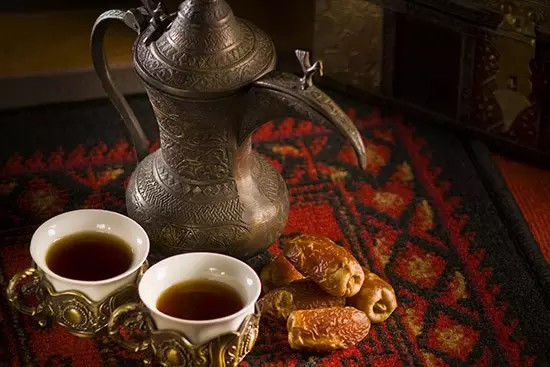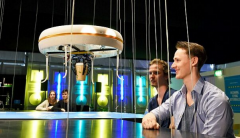Hiding a traditional coffee pot, Kuwait Cafe.
Long before coffee became popular in Europe, it was actually a social drink in the Arab world. Coffee originated from the Arabic Qahwa, and in the 17th century, the cultivation and production of coffee was monopolized by Arabs. Even today, you can still feel the strong local characteristics of drinking coffee in Arab countries. the coffee itself smells of spice, and you have to follow a specific procedure to pour it out of specific utensils and grind it with your hands to show your welcome.
Dallah is a century-old traditional coffee maker made of gold, silver, brass, iron and other metals, with a drum body, an elegant curved handle, a towering and exaggerated lid and a long beak-like spout. The surface of the bottle is not forgotten to be engraved with gorgeous and complex patterns, similar to other utensils in the Arab region. This coffee pot has a wide range of influence, and its pattern is on the back of the dirham coin in the United Arab Emirates.



A new cafe called Dallah has been opened in Kuwait, which makes coffee in the traditional way. Local architecture firm associated architects partnership (AAP) has been asked to design a friendly and open environment where people can share a cup of coffee.
The firm's design revolves around three elements, showing a plan, a suspended roof and a functional sidewall. This corresponds to the design of the Dallah as a coffee maker, with a patterned bottle body, a removable lid and a side handle.
The other side of the wall is made up of hexagonal and diamond patterns with a sense of geometry, which is very modern. Green and white are the most commonly used colors in Arab countries, but in some brown diamond patterns, three-dimensional boards are used to make a sense of flying origami.


(the picture and text are from the network yoyo)
Important Notice :
前街咖啡 FrontStreet Coffee has moved to new addredd:
FrontStreet Coffee Address: 315,Donghua East Road,GuangZhou
Tel:020 38364473
- Prev

Korean Coffee Culture Korean Cafe Travel in Korea
When I first arrive in China, I will see a strange phenomenon. No matter whether it is to discuss business, study or have a chat, most of my friends from other countries will have this feeling. Would you like to have a cup of coffee? However, after living in China for a period of time, we all know that Chinese people love to drink coffee, and all kinds of coffee bars can be found on the streets and alleys. Laos is not the country of origin of coffee, but the coffee culture of Laos is already very good.
- Next

The world's first "drone attendant" cafe
The drone acts as a waiter, ordering food and delivering wine to guests. This is not a movie plot, but a real scene in a coffee shop of a university in the Netherlands. The world's first coffee shop using drones has opened at Eindhoven University of Technology in the Netherlands, in what can be called a glimpse of the future, the Australian Broadcasting Corporation reported on April 23. A total of 20 students participated in the program.
Related
- What brand of black coffee is the most authentic and delicious? what are the characteristics of the flavor of the authentic Rose Summer Black Coffee?
- Introduction to the principle and characteristics of the correct use of mocha pot A detailed course of mocha pot brewing coffee is described in five steps.
- Which is better, decaf or regular coffee? how is decaf made?
- How much is a bag of four cat coffee?
- How about four Cat Coffee or Nestle Coffee? why is it a cheap scam?
- Which is better, Yunnan four Cats Coffee or Nestle Coffee? How about cat coffee? is it a fake scam? why is it so cheap?
- How about Cat Coffee? what grade is a hoax? which instant coffee tastes better, four Cat Coffee, Nestle Coffee or G7 coffee?
- Process flow chart of coffee making-Starbucks coffee making process what coffee tastes good at Starbucks
- The top ten best coffee beans in the world Rose summer coffee or Tanzanian coffee tastes good
- Yunnan four cat coffee is good to drink?_four cat coffee is a big brand? four cat blue mountain coffee is fake?

